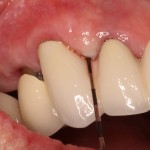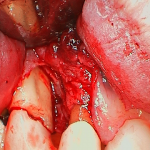Example of Gum Disease Treatment
A current patient of mine presented with recurrent cavity under a fixed bridge and significant probing depth increase. The probing depth increased from approximately 5 mm to 9 mm. The patient was referred to a restorative dentist to remove the permanent bridge and replace it with a temporary. This allows us to determine that the tooth is not hopeless due to gross decay. The patient returned, and I performed a surgical periodontal procedure. This procedure included a combination of bone graft, Gem 21, and membrane. Utilizing these materials for treatment are due to the severity of disease (see pic below). After six months of healing and a permanent fixed bridge, the probing depth was reduced to approximately 3 mm with no inflammation (see pic below).
- Completed Surgical Treatment
- Severe Bone Loss
Periodontal Regeneration Background
Periodontal regeneration is defined as a gum disease treatment for the development of new bone, new periodontal ligament, and new cementum on a root surface. Advancements in periodontal regenerative materials has allowed periodontists to achieve true regeneration where before it was impossible. These innovative materials include bone grafts, biologic mediators, guided tissue regeneration, and growth factors. Treatment predictability / success is related to case selection and correct surgical management by a periodontist.
Growth Factors
Enamel matrix derivative (Emdogain) is an acidic extract of extracellular enamel matrix and exerts various biologic functions. They increase these biologic functions through cell-surface receptors. This mechanism increases periodontal regeneration by the recruitment of cementoblasts to the root surface. Therefore, leading to the formation of root cementum, periodontal fibers, and alveolar bone.
Platelet-derived growth factor (Gem 21) are naturally occurring biologic molecules that mediate and regulate key cellular events. These processes that are crucial to regeneration includes chemotaxis, cell proliferation, and matrix synthesis. Gem 21 accomplishes this by binding to specific cell surface-receptors. This binding enhances and promotes a cascade of events, including rapid cellular migration and proliferation, that leads to a wound healing response.





 by
by 


